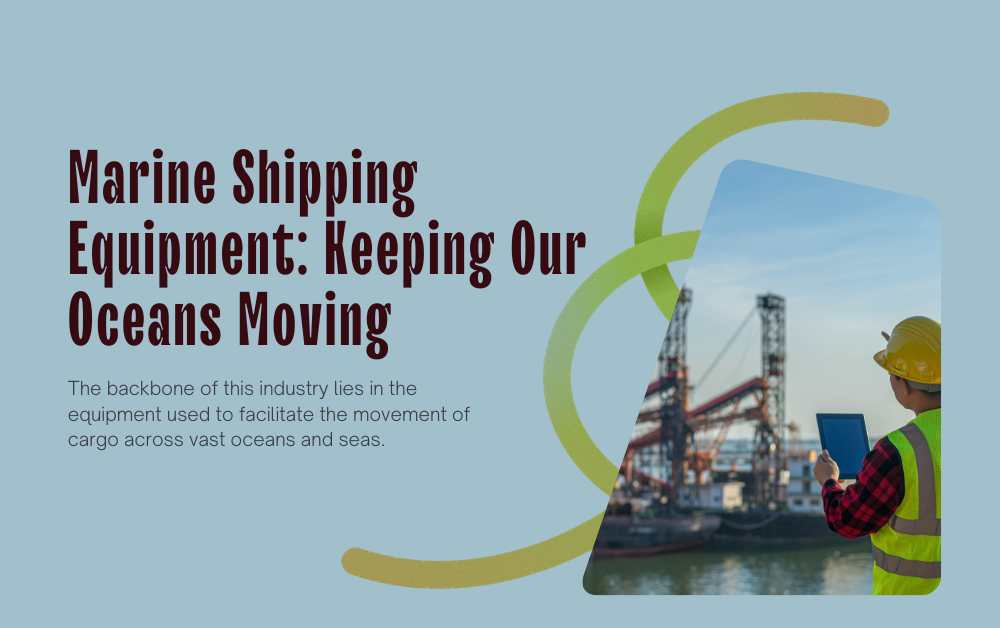When it comes to global trade and transportation, marine shipping plays a crucial role in ensuring goods reach their destinations safely and efficiently. The backbone of this industry lies in the equipment used to facilitate the movement of cargo across vast oceans and seas. In this blog, we will explore the essential marine shipping equipment that keeps the world’s economy afloat, from cargo ships to container terminals.
But our voyage doesn’t stop there. The importance of environmental sustainability in marine shipping cannot be overstated. We will also navigate the waters of eco-conscious equipment, discovering how the industry is striving to reduce its ecological footprint. Furthermore, we’ll cast a spotlight on safety equipment, an indispensable aspect of marine shipping, ensuring the well-being of both crew and cargo.
So, fasten your seatbelts—metaphorically speaking, of course—and prepare to embark on an odyssey through the world of marine shipping equipment. It’s a journey that will not only unveil the machinery and mechanisms that underpin global trade but also shed light on the industry’s commitment to preserving our precious oceans and safeguarding the lives of those who venture out onto their unpredictable waters.
Cargo Ships: The Workhorses of the Sea
Cargo ships are the heart of marine shipping, responsible for carrying a significant portion of the world’s goods. These vessels come in various sizes and types, each designed for specific purposes. Here are some common types of cargo ships:
1. Container Ships
Container ships are the most recognizable vessels in the shipping industry. They transport standardized containers, making it easy to load, unload, and transfer cargo between ships, trucks, and trains. These ships come in various sizes, with some of the largest capable of carrying over 20,000 containers.
2. Bulk Carriers
Bulk carriers are designed to transport unpackaged cargo, such as grains, coal, and ore. They are characterized by their massive storage holds and often have conveyor systems for efficient loading and unloading.
3. Tankers
Tankers are specifically built to transport liquid cargo, including oil, chemicals, and liquefied natural gas. These ships are equipped with specialized tanks and systems to ensure the safe transport of hazardous materials.
4. Ro-Ro Vessels
Roll-on/Roll-off (Ro-Ro) vessels are designed to carry vehicles and other wheeled cargo. They have built-in ramps and are ideal for transporting cars, trucks, and construction equipment.
5. General Cargo Ships
General cargo ships are versatile vessels that can carry a variety of goods, including machinery, equipment, and packaged goods. They often have multiple cargo holds and various types of cranes and hoists for loading and unloading.
Port Equipment: Where Land Meets Sea
Ports serve as crucial hubs in the global shipping network, connecting cargo ships to land-based transportation. The equipment at ports plays a pivotal role in ensuring the efficient flow of goods. Here are some key elements of port equipment:
1. Cranes
Cranes are a common sight at ports, used for lifting and moving cargo between ships, trucks, and storage areas. There are various types of cranes, including gantry cranes, container cranes, and mobile harbor cranes.
2. Forklifts
Forklifts are essential for moving cargo within the port, especially in container terminals. They can handle containers and other heavy loads with precision, making them indispensable for efficient operations.
3. Conveyor Systems
Conveyor systems are used for the automated movement of cargo within ports and warehouses. They can transport goods over long distances and are particularly useful for bulk cargo handling.
4. Terminal Tractors
Terminal tractors, also known as yard trucks or shunt trucks, are specialized vehicles used for moving trailers and containers within the port area. They are designed for tight turns and maneuverability.
5. Port Security Equipment
Port security is of utmost importance to protect both cargo and personnel. Equipment such as surveillance cameras, access control systems, and perimeter fencing helps ensure the safety and security of port facilities.
Navigation Aids: Safeguarding Maritime Traffic
Safe navigation is paramount in marine shipping to prevent accidents and collisions. Navigation aids are essential for guiding vessels through the often treacherous waters. Here are some critical navigation aids:
1. Lighthouses
Lighthouses have been a symbol of maritime safety for centuries. They emit powerful beams of light to guide ships away from dangerous coastlines and shallow waters.
2. GPS and AIS
Global Positioning System (GPS) and Automatic Identification System (AIS) are modern technologies that provide real-time tracking and navigation information to vessels. They help ships maintain accurate positions and avoid collisions.
3. Buoys
Buoys are floating markers used to indicate safe channels, hazards, and navigational information. They come in various shapes and colors, each conveying specific information to mariners.
Also Read – Marine anchor chain supplier in Oman
Environmental Equipment: Navigating Towards Sustainability
The marine shipping industry is increasingly focusing on environmental sustainability to reduce its ecological footprint. Several pieces of equipment and technologies are helping ships become more environmentally friendly:
1. Scrubbers
Scrubbers are air pollution control devices that remove harmful pollutants from a ship’s exhaust gases. They reduce the emission of sulfur dioxide and other harmful substances into the atmosphere.
2. Ballast Water Treatment Systems
Ballast water treatment systems are used to prevent the spread of invasive species by treating ballast water before it is discharged into new environments. This helps protect local ecosystems.
3. Energy-Efficient Propulsion Systems
Advancements in propulsion systems, such as the use of LNG (liquefied natural gas) as a fuel source, are making ships more energy-efficient and environmentally friendly.
Safety Equipment: Ensuring the Well-being of Crew and Cargo
Safety is a top priority in marine shipping, given the inherent risks of working at sea. Here are some essential safety equipment and measures:
1. Lifeboats and Life Rafts
Lifeboats and life rafts are critical for evacuating crew members in case of emergencies such as shipwrecks or fires. They are equipped with essential supplies and communication devices.
2. Fire Suppression Systems
Fire suppression systems, including sprinklers and fire extinguishers, are vital for preventing and containing fires on board ships.
3. Emergency Communication Systems
Reliable communication systems, such as satellite phones and distress beacons, ensure that ships can call for help in emergencies, even in remote areas.
Conclusion: Navigating the Seas with Marine Shipping Equipment
Marine shipping equipment is the unsung hero of global trade, enabling the movement of goods across oceans and connecting countries and continents. From cargo ships to port equipment, navigation aids to environmental and safety equipment, each component plays a crucial role in the smooth functioning of the industry.
As the world continues to rely on marine shipping for its transportation needs, it’s essential that we recognize and appreciate the technology and equipment that make it all possible. With a focus on sustainability and safety, the marine shipping industry is evolving to meet the challenges of the future while ensuring the well-being of our oceans and the people who depend on them.
Read next blog – From Tradition to Empowerment: The Evolution of Women’s Day Flowers



